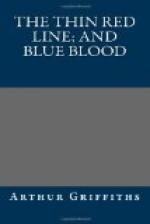Lord Raglan was not long in doubt. He knew the weakest point of the British position, and rightly guessed that the enemy would know it too.
“I shall go to Inkerman,” he said. “That is their real point, I feel sure. And we must have up all the reinforcements we can muster. You, Burghersh, tell Sir George Cathcart to move up his division and support Pennefather and Brown. You, Steele, beg General Bosquet to lend me all the men he can spare.”
Pennefather had his hands full by the time Lord Raglan arrived. With a paltry 3,000 odd men he was confronting 25,000; but, happily, the morning was so dark and the brushwood so thick that his men were hardly conscious that they were thus outnumbered.
Not that they would have greatly cared; they were manifestly animated with a dogged determination to deny the enemy every inch of the ground, and with unflagging courage they disputed his advance, although they were so few. Once more it was the “Thin Red Line” against the heavy column: hundreds against thousands, a task which for any other troops would have been both hopeless and absurd.
But Pennefather’s people stoutly held their own. On his left front, one wing of the 49th Regiment routed a whole Russian column, and drove it back at the point of the bayonet down the hill; to give way in turn, but not till it was threatened by 9,000 men. Next, four companies of the Connaught Rangers stoutly engaged twenty times their number, and only yielded after a stubborn fight. General Buller came up next, with a wing of the 77th, which was faced by a solid mass five times as strong.
“There are the Russians,” cried Egerton, who commanded the 77th. “What shall we do, general?”
“Charge them!” was Buller’s prompt reply.
The next instant the slender line, with a joyous hurrah, was engulfed in a giant column. The effect was instantaneous. The Russian column reeled before the fiery charge, wavered, then broke and fled.
More to the right, Mauleverer prolonged the line with the 30th, and gave so good an account of the Russians in his front that they, too, fell back in disorder; and Bellairs, with a party of the 49th, was equally triumphant.
Beyond these forces, General Wilders, with whom young McKay now rode as extra aide, led a fraction of his brigade, including the Royal Picts, against the Sandbag Battery, a point deemed important because it commanded the extreme right of the position.
On the far sides of the slopes, beyond the battery were 4,000 Russian troops, and the mere sight of Wilders with his deployed line sufficed to shake the steadiness of the foe. The Russian bugles sounded a retreat, the leading companies faced about, and, communicating the panic to those behind the hill, the whole mass gave way and ran down the slope, followed by a destructive fire from the British line.
Thus ended the first phase of this unequal contest. Pennefather had triumphed to an extent of which neither he nor his heroes were fully aware. Barely 1,200 men had routed 15,000! The few had achieved a decisive victory over the many.




